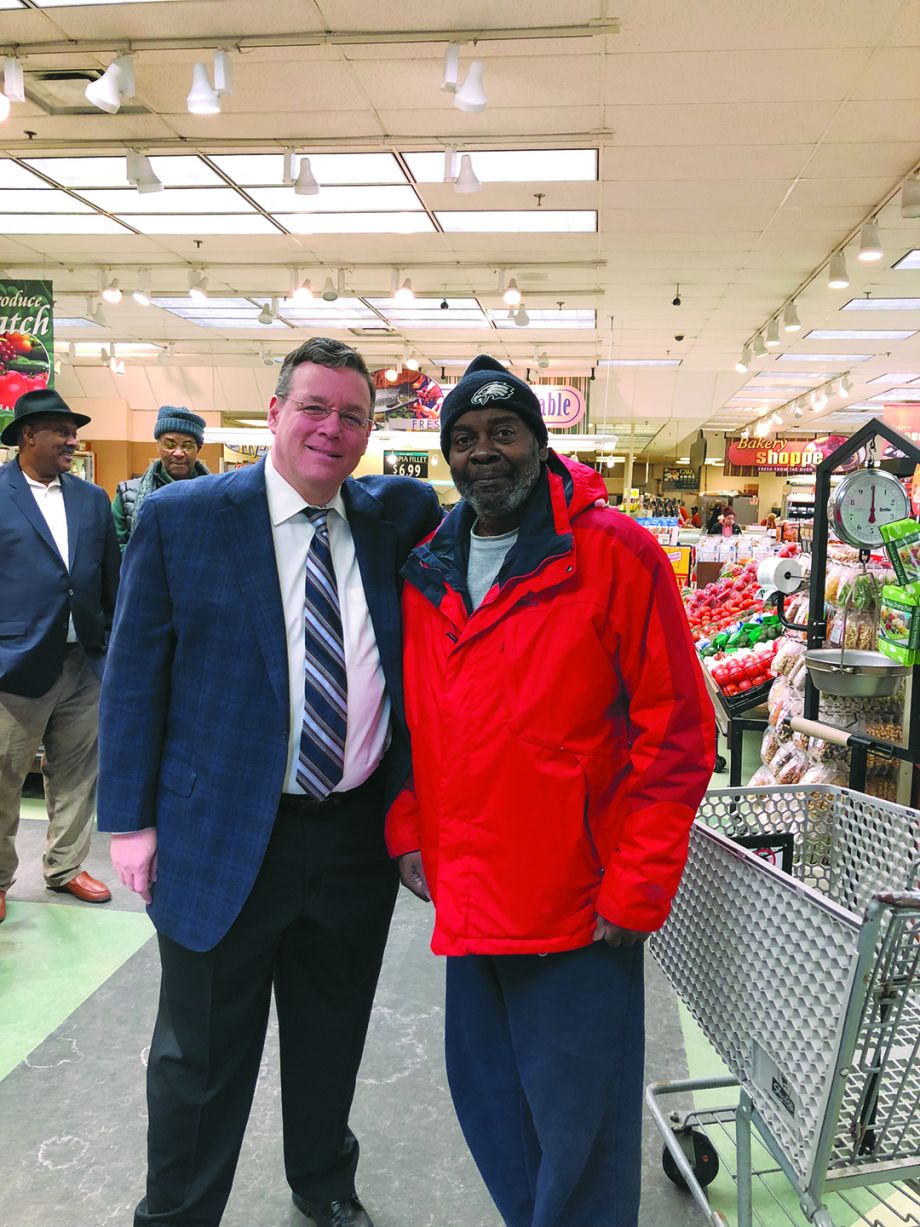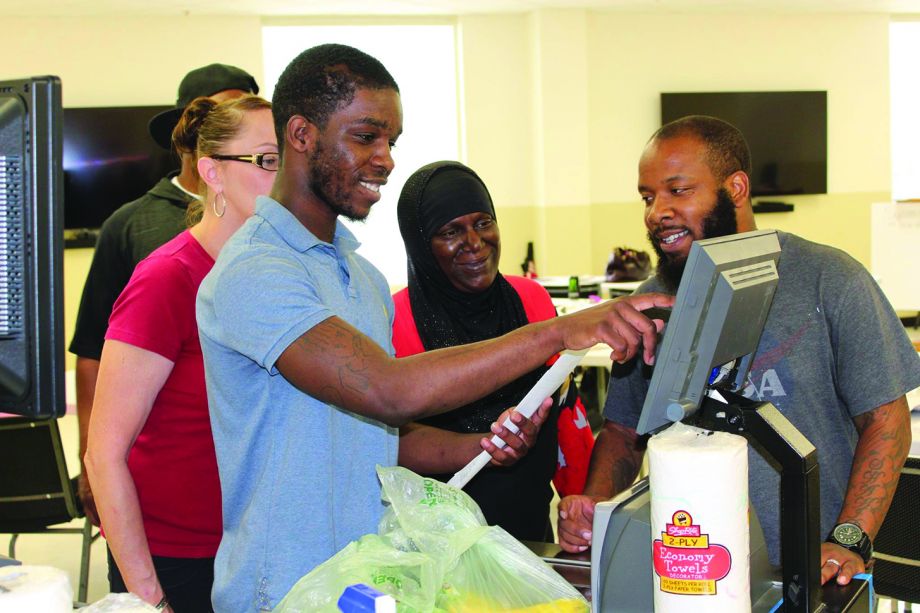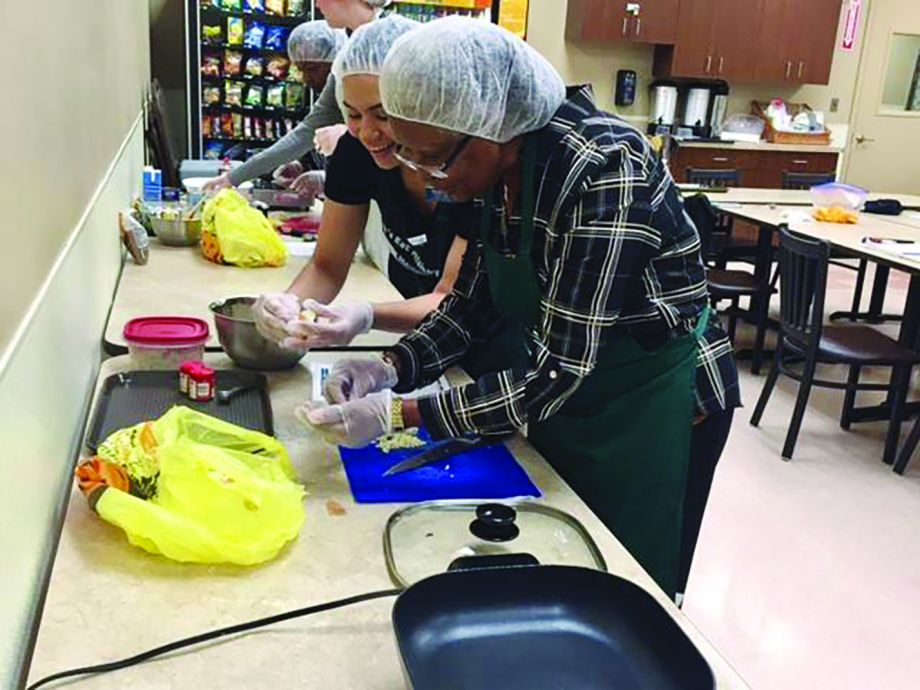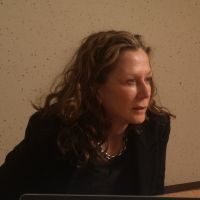Are You A Vanguard? Applications Now Open
Anita Anim, MPH, RD, LDN, an Uplift dietitian, shows Shop-Rite customers Major and Hannah Ashlock how to determine whether a product is made with whole grains by reading the nutrition facts label.
Photo by Audrey Fish
This is your first of three free stories this month. Become a free or sustaining member to read unlimited articles, webinars and ebooks.
Become A MemberEDITOR’S NOTE: The following is excerpted from “The Intergalactic Design Guide: Harnessing the Creative Potential of Social Design,” by Cheryl Heller, published by Island Press. In it, the author posits 11 common principles for social design and offers nine in-depth case studies that embody one or more of her social design principles, including the story of Brown’s Super Stores, excerpted here.
Three days a week, Jeffrey Brown wanders the aisles of grocery stores, through the dairy department and frozen food, the cereals and snacks and the produce. He watches what people choose to eat, whether and how they read ingredient labels, whether they find what they want. He lunches at simple tables near salad bars and prepared-food stalls, making himself available for whatever conversations people want to start. Brown is a one-man customer service center, but instead of doling out rote responses meant to end interactions as efficiently as possible, Brown makes sure his encounters are real dialogs, always in person, sometimes personal, and often begun or ended with a big hug. This is how Jeffrey Brown leads, by working with the people he serves.
He has built an empire from these relationships and the insights they’ve inspired. A fourth-generation grocer, Brown now runs one of the largest supermarket businesses in Philadelphia: $600 million in sales and counting, with some three thousand employees. He is chairman of the State of Pennsylvania Workforce Development Board, the Philadelphia Youth Network, and the Pennsylvania Food Merchants Association. He’s been an advisor to both Barack and Michelle Obama.
Brown’s Super Stores are part of the ShopRite cooperatively owned national organization. From a distance, it looks like other successful enterprises. The business has grown steadily and makes a profit. The team is adept at marketing and sales, operations, and customer service. The way it grows can seem conventional as well: expanding into new markets, testing and adding new products and services, doing more of what works and phasing out what doesn’t. Upon closer inspection, though, contradictions emerge. Brown’s Super Stores turns the accepted wisdom about American enterprise upside down: its locations are not prime; its customers are not affluent. The company breaks the rules about how a smart business behaves, taking on problems far beyond its core business and outside its comfort zone. That’s when it becomes apparent that Jeffrey Brown isn’t ultimately in the business of selling groceries at all. He is in the business of ending poverty and its side effects. Building a successful grocery empire is simply the way he does that.
It is this hidden higher purpose behind the explicit one (in Brown’s case, growing a successful grocery empire) that distinguishes social designers. They combine traditional business success with an audacious intention to create greater social value, and they view what they do as the means rather than an end in itself. Like any elegant, systemic creative solution, this is a virtuous circle. Brown would not be effective in tackling poverty if he didn’t have the granular view of its causes and the opportunities that his stores provide, and his business would not be successful if it didn’t go beyond exchanging money for products to help his customers thrive. Looking for the ultimate “why” behind any enterprise is a useful way to understand successful social design in action.
The neighborhoods Brown’s Super Stores enters and succeeds in are those others have fled, in places where it’s been repeatedly “proven” that no business can thrive. They are places where the median income is $25,000 per year and far too many people have criminal records that prevent them from getting jobs. Jeffrey Brown has made these challenges his business.
Simply by asking, Jeffrey Brown discovered that economically disadvantaged people want to buy the things they want to buy: the brands they recognize, the ingredients their favorite family recipes call for, with uncompromised selections of quality and sizes. They want to shop in stores that are clean and attractive, staffed by people who treat them with respect. He’s also discovered that when customers are listened to and provided with what they want, a superstore can help address structural poverty and poor health as well as hunger, that it can offer second chances to returning citizens who’ve been taught by experience they will never get a break.
With necessity as inspiration, Brown developed innovative financial structures to support a business empire selling things more expensive than its customers can afford and started a school for formerly incarcerated employees. All of this is now available to other cities through a nonprofit consulting arm called Uplift.

Jeffrey Brown, left, poses in one of his stores with a customer who has shopped in three generations of his family’s grocery chain. (Credit: Brown’s Super Stores)
What’s remarkable about Jeffrey Brown as a person is that he’s not afraid to uncover problems bigger than those he knows how to solve. This is another common characteristic of great social designers. A willingness to eschew preconceived conclusions and look for what is “there” instead of what is expected, requires fearlessness — confidence in the resourcefulness and resilience of one’s team and the tenacity to find an answer to whatever problem is uncovered. Brown has learned that if you ask people what they want and what’s bothering them, you can’t be afraid of what you’ll hear. His relish of new challenges shows up more than once in the same conversation, whether he’s talking about obesity, the number of guns in a neighborhood, or the burdens of the formerly incarcerated. “That sounded like a problem that could be solved,” he says.
It was at a gathering of grocers from across the state of Pennsylvania where the defining problem and opportunity first emerged. Someone pointed out that the average lifespan is up to twenty years less for people who live in neighborhoods without suburban-quality grocery stores, and someone else tried to unload a store in just such a neighborhood because there was “absolutely no way to make it work.” When Brown expressed interest in buying it, he was advised to “walk away” from this guaranteed failure with its intractable people and complex issues. “You’re young,” the seller said, implying that Brown shouldn’t launch his career with a failure. “This is someone else’s problem.” That was when Brown decided to make it his own.
But instead of assuming that he, as someone who had grown up in the business with a father and grandfather to show him the ropes, already had all the answers, Brown wanted to know why the last owner had failed. He invited everyone in the community to a meeting, as many as would come. He included not only the local ministers and NAACP representatives he already knew but also the “divisive” voices and the skeptics; all the people who could impact his success or failure were invited into the “tent.” This first decision was, for Brown, as for anyone else intent on improving lives, the defining one: whether to retreat to the safety of one’s own environment and confer with a like-minded expert team or venture into the unknown to ask questions and be willing to hear unanticipated, and often unwanted, answers. In social design, it’s important to first identify and then question all assumptions — in this case, the “way things are done,” or the common sense of the grocery business. It’s a matter of questioning your own and your industry’s beliefs and mental models instead of assuming that something or someone else is at fault. It requires tolerating things that make you uncomfortable, being willing to question the status quo even when it threatens the foundations of your enterprise. Most of the time, when leaders say they want to change things, they mean they want to change anything and everything except themselves and the structures upon which their power is built.
The first obstacle to emerge at the gathering in Southwest Philadelphia was the cynicism engendered by the prospect of “another great white hope” showing up with answers and preconceived opinions that residents had heard so many times before. When local community leaders stepped in and asked people to be patient long enough to listen, they began to sense a different character in Brown, to trust him enough to tell him why the last business owner, who thought he had all the answers, failed.
“The owner assumed we were criminals,” they said, “and they treated us that way.” Beauty products were displayed behind the counter, in a way that said, “We know you’ll try to steal them if we put them within your reach.” Carts were barred from the parking lot out of fear that if people could take them out there, the carts would “walk away.” Security was obvious and heavy-handed. Employees sent to work in that location were perceived as “leftovers,” after the best people had been sent to stores in richer neighborhoods. In general, they thought, the store was stocked and staffed “like we’re inferior people.” They wanted first-quality products, choice, and service. That, Brown says, was evidence that the last owner had failed even the basics of quality, cleanliness, and service, the essential requirements of running a good grocery store.
But there was more. “We’re from North Africa,” some said. “We don’t eat the food that was sold in that store.” Or “We’re Muslim, and there was no halal.” In addition to basic insufficiencies, the previous store owner was ignorant of, and disinterested in, what his potential customers wanted to eat.
Brown left the meeting with not only an understanding of what was needed but also a good sense of the innovation it would take to deliver it. “There is a gap,” he says. “When people want the same products affluent people buy but don’t have the money to pay for them, that’s a nonstarter for a business.” In 2000, the Clinton administration initiated the New Markets Tax Credit Program, specifically intended to attract private investment to distressed communities. Brown was one of the first businessmen to utilize this new program. From it, he designed a public-private partnership to close the gap between the desires and means of his customers. And he began his first prototype.
The path from that first store to today has been a regular rhythm of inquiry and dialog with the people in the communities where he does business, followed by experiments in overcoming the problems and meeting the needs he’s heard about. Typically, some of the needs uncovered fall within the purview of a grocery superstore, while others are far beyond. It is the rhythm of prototypes and refinement based on feedback from customers that is essential to the social design process.
Neighbors are proud of the role they play in the success of Brown’s Super Stores, and they want to continue to help guide Brown’s progress. When Brown and his teams intend to try something risky, they start with a town hall meeting in the neighborhood where it’s planned. He tells people what he’s thinking and asks if he’s on the right track. The power of giving people agency is infectious. Meetings have become so popular that it’s often difficult to find a venue large enough to hold the thousands of people who attend.
In one meeting, a woman asked if Brown had ever thought about all the previously incarcerated people in the neighborhoods. “Your business is limited by the fact that a lot of people you serve are former inmates who can’t get jobs,” she said. “If they can’t get jobs, they can’t buy your products.” Though he had never considered becoming the person to tackle it, this was one of the times he said, “That seems like a problem that can be solved.” With nowhere to turn for advice, he hired half a dozen “really great” people, many of whom had experienced the system from the inside and found their way out. One outcome of this conversation is Uplift, the nonprofit Brown founded in 2009. Among other services, Uplift trains people with criminal records to work in the grocery business and guarantees them jobs.

A future employee learns the grocery business at Uplift's workforce training program. (Photo by Anita Anim)
In a dedicated, spacious facility that’s part classroom, part model grocery store with checkout stations and a variety of stocked shelves, about thirty students at a time come for training all day every day for six weeks. In addition to the hard skills required for the jobs they’ll be doing, they learn the power skills they’ll need to thrive in a collaborative environment that serves the public. Having a job is essential, but it’s not the only requirement for success; classes include coaching on the basics of banking and personal finance, with one-on-one counseling along the way if it’s needed. Since Uplift’s founding in 2009, enrollment has steadily increased. People who have “touched the criminal justice system” now make up more than 15 percent of Brown’s Super Stores’ workforce, from entry-level positions to department managers. The waiting list for spots in the program gets longer all the time.
Just as Brown’s is in it together with the communities, Uplift is in it together with trainees. Faculty and counselors learn what people need and how best to help them in the process of teaching. The team members have seen firsthand the dynamics of poverty; for example, if you can’t get a job and support your family, it’s not illogical that you might turn to selling drugs. They have also learned that with the right opportunities, the same skills required to be a successful drug dealer can be applied to the management of a profitable dairy department.
Brown enticed a successful young banker to come on board to run Uplift. His previous job had been to open new locations and financial opportunities for the bank. Brown suspected that those same skills could be put to use creating new markets to serve poor people in troubled communities, and he was right. Atif Bostic is now Uplift’s executive director, putting his entrepreneurial and financial training together with a purpose he finds far more fulfilling than working in a bank. He is leading Uplift’s expansion, consulting with businesses in fourteen states, and some of the other 25 million Americans who live in food deserts, to help them adapt and put into practice what the Philadelphia chain has learned.
Uplift also partners with Brown’s team, prototyping other ideas to help the stores become a cornerstone for good health. The stores have introduced onsite dietitians, who give aisle tours to anyone wanting to learn about nutrition and how to decipher the small and arcane print on ingredient labels. There are cooking classes, one-on-one dietary consultations, and regularly scheduled check-ins to see how people are managing their weight and diabetes. Government-supported health clinics offer care in two of the stores. Mini-branches of credit unions, with free services, are on-site for anyone who can’t afford to do business with traditional banks.
Experiments have included everything from whether healthier versions of traditional food will be accepted, such as fire-grilled chicken instead of fried (resoundingly yes), and whether calorie consumption can be reduced by rearranging food on shelves, as in putting low-fat milk where the full-fat is normally displayed (mostly no), to whether a grocery store can play a positive role in reducing gun violence in tough neighborhoods. The latter pilot, which came from another discussion at a town meeting, involved buying guns from anyone willing to unload them for $50 grocery gift cards. Results included 10,000 guns turned over to the police department to be taken out of commission. Although the program succeeded in accumulating guns, it was stopped after a few years because it didn’t produce enough hard evidence that collecting guns is the same as reducing violence. Funders lost interest.

At an in-store cooking class taught by nutrition educators from the Health Promotion Council, Alyssa Mills, a La Salle University dietetic intern, shows a participant how to properly peel and chop fresh garlic. In the class, called “A Taste of African Heritage Cooking,” participants prepared the Oldways Caribbean Coconut Red Bean recipe. (Photo by Anita Anim)
What’s important to note with these experiments is that prototypes can be designed as small risks, without great expense. In contrast with traditional new product launches, which take months or years of preplanning and expensive marketing campaigns, there is greater freedom in prototyping to fail and to learn from what doesn’t work. It’s easier to maintain objectivity when evaluating experiments because no one’s career (or next quarter’s earnings) depends on their success. In the case of Brown’s Super Stores’ gun collection, although the program ended when no hard evidence could be found that violence was reduced, this shared effort between store and community offered important learning for everyone involved.
Good grocers are masters at evaluating data, and they have access to an enormous amount of it. With stats on everything that comes in and out of their stores, they know almost immediately if a product is selling or a service is working, whether an item is popular at a particular place on a shelf or should be moved. They know how that item did a year ago and, using historical trends, how it’s likely to do in the future. But with Brown’s infallible instincts for social design, he never lets data take the place of the feedback loops he has set up through his relationships with the people who come into his store. Data are how Brown evaluates the results of the pilots he innovates. He believes that the people he serves know the blueprint for success, for his stores as well as for themselves. “Whether it’s on food consumption, exercise, or substance abuse,” he says, “most of us know what we should do, even though we don’t do it.” And regardless of how successful a business becomes, it’s important never to fall back on what we think we know instead of continually seeking new learning within the communities served. (Editor’s Note: Brown was criticized by some when he went on record opposing the Philadelphia sugary-beverage tax, intended to fund a significant revamp of parks and green space as well as the city’s universal pre-K program. Brown believes his already-slim profit margins would be hard-hit by the loss of beverage revenue and says since the tax was implemented revenues are down 15 percent.)
Although Jeffrey Brown is skeptical that a business such as his can be scaled up in a traditional way — wasn’t that the problem in the first place, that chains thought they could open cookie-cutter operations everywhere? — his philosophy and the principles of his approach are spreading. One day in 2008, presidential candidate Barack Obama walked into a Brown’s Super Store unannounced. Wheat prices had gone up, and he thought there was a chance that the topic might come up in his next debate with Hillary Clinton (Brown points out, as would Marie Antoinette, that wheat prices have caused governments to fail). Obama wanted to do his own research in a place where wheat products were sold and to develop a point of view on the issue. The future president took notice of the store, of its uniqueness, the place it occupied for the people of the neighborhood and the services it provided to them. Both men got long-term benefits from the impromptu visit. Brown helped Obama prepare for the debate and continued to advise and influence him and the first lady, including inspiring her legacy “Let’s Move!” program to combat obesity. In this way, through still another person (who happened to be a future president) willing to step into the on-the-ground reality of people he wanted to serve, the principles and practices that have driven Jeffrey Brown have influenced millions of other people.
Still a relatively young man, Brown is by no means finished. He thinks a lot about poverty, which he considers our country’s biggest problem. He thinks about the U.S. Department of Labor, all the money it spends, and how poorly designed it is. He thinks about how the insurance industry is structured and why it needs to be that way. Whatever he decides to do next, he will continue his process of co-creating with his customers, looking for the questions that will guide him in the communities he serves, working through relationships instead of falling back on the industry’s traditional transactional approach, and prototyping big “risks” through experiments with the guidance of the people they affect. He will continue to work on poverty, tackling issues that others avoid and seeing, where they see futility, problems that look like they can be solved. If a grocery store can be a means to solve poverty, what can other businesses willing to lead through social design do? And how much more successful can they be if they create social value for the communities who support them?
Adapted from “The Intergalactic Design Guide: Harnessing the Creative Potential of Social Design,” by Cheryl Heller. Copyright © 2018 Cheryl Heller. Reproduced by permission of Island Press, Washington, D.C.

Cheryl Heller is the Founding Chair of the first MFA program in Design for Social Innovation at the School of Visual Arts in Manhattan, and is President of the design lab CommonWise. She is the recipient of the AIGA Medal for her contributions to the field of design, and a Rockefeller Bellagio Fellowship. Her clients have included Ford Motor Company, American Express, Pfizer, Mars Corporation, Seventh Generation, L’Oreal, and The World Wildlife Fund. She created the Ideas that Matter program for Sappi in 1999, which has given over $13 million to designers working for the public good.

20th Anniversary Solutions of the Year magazine